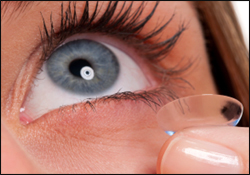Contact Lenses in Pediatrics
As eye care professionals, it is difficult to count the number of times this scenario has played out in our exam rooms.
A child presents for their back to school eye exam with a parent in tow. The exam is uneventful, the prescription is checked, the eye health is thoroughly evaluated, and after all testing is completed and the findings are conveyed to the parent or caregiver, the real crux of the visit finally reveals itself… someone brings up contact lenses.
Suddenly, what was a cordial visit gets a bit more heated.
Parent: “You are WAY too young! I didn’t get them until I was in highschool!”
Child: “But my friend Billy got them two years ago!”
Parent: “Maybe if you could keep your room clean, your mother and I would consider it!”
Child: “But I don’t like wearing glasses, especially under my baseball helmet!”
Parent: “It isn’t safe at your age, we’ll talk about it next year when you’re 13.”
This usually continues rapid fire for 15 to 20 seconds until, exasperated after having made their cases, both parent and child turn in anticipation toward me to cast the deciding vote…
“In reality, you are both right,” I will undoubtedly say.
Let’s look at this rationale in two ways, first by looking at an actual study on the matter and secondly by looking at contact lenses in pediatrics from a real world view point.
The Contact Lenses in Pediatrics or CLIP Study
This study sought to answer the age old question of when is it appropriate (i.e. safe) for children to begin wearing contact lenses? This large study enrolled 84 children from the ages of 8 to 12 along with 85 teens from the ages of 13 to 17 and all participants were brand new to contact lens wear. The demographics of the participants in this study were reflective of the general US population in terms of gender and race. All participants where properly trained, fit with the same brand of contacts for continuity, and then followed at one week, one month, and 3 month intervals, when problems from new contact lens wear are the highest. The follow up visits looked for problems like reduced vision, trouble with putting in and taking out contacts, proper fitting of the contact, and checking the health of the ocular surface with a microscope for signs of inflammation or infection.
When all the data was tabulated, there was no statistical difference in the safety or ability of contact lens wearers in either of the two groups. To put it another way, if proper contact lens training and fitting was performed by the doctors and staff, then 8 year old children wore contact lenses as safely and successfully as 17 year old teens!
Not only that, another arm of the CLIP study looked at the child’s perceived “quality of life.” This survey showed a remarkable 24% improvement in children’s perception of contacts compared to glasses. The largest areas of contact lens preference came in the categories of overall appearance, improved vision, more comfortable activities (sports), and reported self esteem. In other words, all the things that adults love about wearing contacts… children and teens did as well!!
In Reality
Although the studies clearly show that children and young adults of a wide age range can wear contact lenses safely and enjoyed doing so, it certainly doesn’t mean that all children and young adults should wear contacts. The Fairness to Contact Lens Consumer Act (FCLCA) was signed into law in 2003 (way back when congress actually passed legislation), and declared contact lenses as “medical devices,” and for good reason!! Any eye care professional has a slew of horror stories and will willingly tell you that rarely does a day go by without a contact lens wearer presenting to the office for some problem directly related to contact lens over-wear and abuse.
Not surprisingly, severe complications from contact lens wear are a significant contributor to avoidable and preventable blindness in the US. Therefore, far more than any age requirement for contact lenses, it is imperative that there be a responsibility and maturity requirement and especially when you are dealing with the eyes of a child.
When the parents feel that a child has demonstrated the responsibility level required do all the things necessary for proper and safe contact lens wear; no overnight wear, proper care and cleaning, on time replacement, etc. The studies clearly show that with proper training and doctor skill, contact lens wear in children and young adults is a safe, appropriate, and patient appreciated alternative to spectacles.
Thank you as always for stopping by Eye to the Future; we hope you have enjoyed this discussion. Please feel free to email any questions or topics for future discussion to [email protected].
Take care of those eyeballs and we’ll see you next time!



